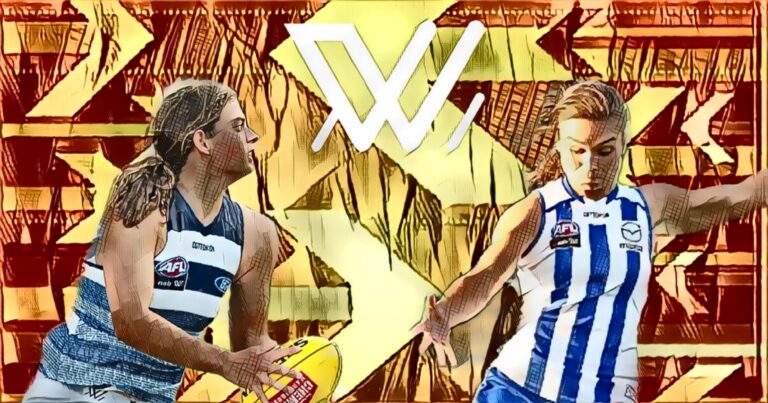AFLW Expansion Part One – 2018 Expansion – Geelong and North Melbourne
After two seasons of eight teams, Geelong and North Melbourne were handed licenses for the 2019 AFLW season, and with that, were allowed to sign as many players as they wanted, with a maximum of four players per club allowed to be poached.
Everyone knows now that North Melbourne went all-in for an established roster and is reaping the benefits of the game’s development, as we’re seeing today.
Collingwood, Brisbane, and the Western Bulldogs all suffered greatly from North’s raid on the competition.
Brisbane lost four players—Tahlia Randall, Jamie Stanton, Brittany Gibson, and Kaitlyn Ashmore—all of whom were in the Lions’ Grand Final sides of 2017 and 2018.
Randall remains the only one left in that quartet still with the Roos, and she’s transformed herself from a key defender to a key forward who can excite with her aerial presence.
But it’s also fair to say Ashmore, Gibson and Stanton, even though she was a Roo for one year before heading to the Gold Coast, were all still substantial contributors for the club.
The Lions went from Grand Finalists in 2018 to having the second-worst win-loss record in the AFLW in 2019, and while they eventually battled back and became one of the best teams in the competition over the past few years, this isn’t the only time where the Lions have been ravaged by expansion, nor been too pleased about having their players taken away.
Collingwood also lost four players to North Melbourne over the off-season, and these hurt the club. The Pies lost Jasmine Garner, Emma King, Moana Hope and Jess Duffin to the Roos.
Hope didn’t last too much longer in the AFLW, playing one season for the Roos in 2019 before being cut at the end of the season.
However, the other three players made a serious impact on North Melbourne. Garner is now revered as one of the greatest players in the AFLW at present, King has carved an important role as a ruck-forward and Duffin was named in the AFLW All-Australian side in 2019 after starring in defence.
The result for Collingwood though was ghastly, finishing in 2019 with the worst record of all ten clubs, at one win and six losses. But it was more than just the losses to the playing list that hurt.
The Pies in 2018 finished in sixth – despite being the third-worst record in the competition, it wasn’t a terrible year, they were quite competitive in a lot of their games, and all three of their wins came in the final four rounds of the season.
But Geelong’s inability to recruit AFLW players over to the Cattery during their signing period resulted them in landing the first two picks of the 2018 Draft, and compromising Collingwood’s position.
In the earlier days, clubs could nominate which state they wanted to play in. In this Draft, the Cats were only eligible to pick players who had nominated for the Vic Country draft pool. Otherwise known as Geelong getting a talent pool to choose from. It saw a lot of Geelong Falcons girls get drafted to the Cats in the early years, and a few girls from other country-based talent league clubs like Greater Western Victoria, Bendigo and Murray Bushrangers.
But imagine this scenario for a moment – if we were to take both North Melbourne and Geelong out of the draft and allow them to enter the comp a few years down the track, and it was just the eight clubs drafting in 2018, the Pies would’ve been in the box seat to land Nina Morrison with their first selection which would’ve sat pick three.
You could also mount an argument they could have taken Rebecca Webster (initially drafted pick seven) or Olivia Purcell (pick 14) in an eight-team draft.
For a little bit of fun, I did a quick revision of the draft in 2018 with just the eight teams and it would’ve seen the top 10 selections as follows:
1. Maddy Prespakis – Carlton
2. Jasmin Stewart – Fremantle
3. Nina Morrison – Collingwood
4. Tyla Hanks – Melbourne
5. Alyce Parker – GWS
6. Nikki Gore – Adelaide
7. Paige Parker – Brisbane
8. Jordyn Allen – Western Bulldogs
9. Rebecca Webster – GWS
10. Katie Lynch – Melbourne
Because Collingwood got pick 13 as compensation for losing their players, they would’ve lost out on the opportunity to draft Mikala Cann with that selection.
So I suppose it’s a double-edged sword. In the actual scenario, the Pies still ended up with good players with their first selections. Jordyn Allen is an important player in their back half, Cann has been good as an inside midfielder and managed Lauren Butler at pick 18 who has forged a solid career to date as a half-back flanker.
The Dogs lost 2018 league best and fairest Emma Kearney, as well as emerging players Jenna Bruton and Daria Bannister to North Melbourne. The loss of Kearney was a massive blow, given just how important she was to the Dogs’ premiership success, and were stiffed by the league, when they received a third-round pick as compensation for their losses.
Unsurprisingly, the Dogs finished at the bottom half of the competition in terms of win-loss records in 2019, only securing just two wins and it perhaps got worse from there. We’ll get to it soon.
North Melbourne also secured someone called Ash Riddell as an expansion signing during this period as well, and as far as I can tell, she’s done alright for herself, taking home a couple of All-Australian blazers and becoming not just a staple in North’s midfield today, but perhaps one of the best midfield accumulators in the competition.
As far as Geelong went, they signed four players out of Melbourne, which as we know now, didn’t really affect the Dees too much, nor impacted Geelong greatly in their early years
Melissa Hickey was good for the rest of her stint in the AFLW and was a good leader for the Cats, but was on the wrong side of 30 by the time she arrived to the club, Richelle Cranston was a solid pick-up as well before being delisted in 2021. Erin Hoare played one season and then focused on life outside of football before returning for another season last year and Anna Teague didn’t play too much after arriving at the Cats.
They also picked up Aasta O’Connor, Maddie Boyd and Phoebe McWilliams from the Bulldogs and GWS respectively. O’Connor was an aging veteran in this time, as was McWilliams, but both offered stability as key position players over the short term, while Boyd has been a serviceable ruck/key position over the years.
Whilst not substantial losses and gaining the star that is Alyce Parker in the 2018 AFLW Draft, the Giants went from three wins and a draw in 2018 to just two wins from seven matches in 2019.
So no matter which way you slice it, all four sides mentioned here: Collingwood, Brisbane, GWS and the Western Bulldogs, all suffered setbacks from this round of expansion, and while the likes of Brisbane and Collingwood bounced back in the next few years, it took the other two sides a little longer to get going.
When asked about expansion ahead of the 2019 AFLW season, Western Bulldogs’ head of the women’s program, Debbie Lee, warned of the dangers of expanding to quickly into the development of the competition:
“We’ve got young talent coming through and they’re going to be good players. But the questions around that is how much senior football have they actually played and will they be able to take the next step?
“AFLW is no longer a four-month program… The competition needs to look at the timing of the VFLW compared to the AFLW and look at the philosophy more broadly around the VFLW.”
For context, the VFLW season in 2018 ran from May to September with a 13-team competition, playing 14 games over 16 rounds, with the top four clubs progressing through to the Finals.
But it still raised the question of how the VFLW could run a season with double the number of games to that of a national league.
2019 saw the beginning of a conference system that was flawed from the start. One conference saw Adelaide, Fremantle, North Melbourne and Melbourne all secure positive records in their group, yet only two of those teams managed to qualify for the final four.
The other conference saw Carlton as the only side to manage a positive win-loss record, winning four games from seven matches.
Whilst the Cats finished second in that group, a win-loss record of 3-4 and a weak percentage of 65.5 meant they were going to be outmatched by their opposition in the preliminary final.
And that’s exactly what happened. Adelaide were the eventual premiers in that year, but stomped the Cats in every facet of the game and won by 66 points – the Cats only kicking 1.1 from 14 inside 50 entries.
It was indicative of things to come. Whilst North went from strength to strength over the coming years, the Cats had struggled to get any momentum in terms of results.
In a compromised 2020 season, the Cats only managed just two wins from six starts. A year later, the Cats were consigned to second-last place on the ladder, with just one win from nine games.
Ahead of the 2021 AFLW Draft, this chain of results prompted the AFL to step in and grant the Cats special assistance. The assistance landed the Cats two mature-aged players in Olivia Fuller and Claudia Gunjaca, both of whom are still on their list (yes Fuller is inactive, but still counts), as well as handing them an extra two first-round picks – those were picks seven and nine.
The Cats took Zali Friswell and Gabbi Featherston with those extra picks, on top of the Georgie Prespakis selection with pick two for finishing up in 13th that year.
The concessions didn’t help the Cats in season six at the start of the 2022 calendar year, a poor year only saw them win two games from 10 matches.
However, the Cats finally picked up some in season seven later on in the year, although it did take half the year to really flex some muscle on their scoring. They picked up seven wins to finish fifth on the AFLW ladder.
The Doc is the heart and soul of our AFLW coverage. He pours himself into it to provide the best in the business. If you come here for AFLW stuff and enjoy what he does, please consider buying him a coffee for the work he does by clicking the link below. I’m sure he’d greatly appreciate it.



